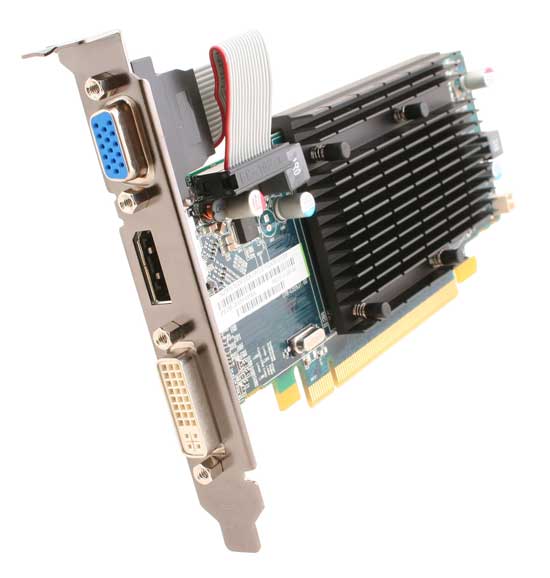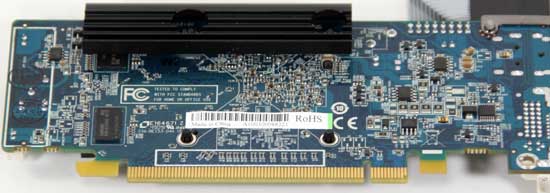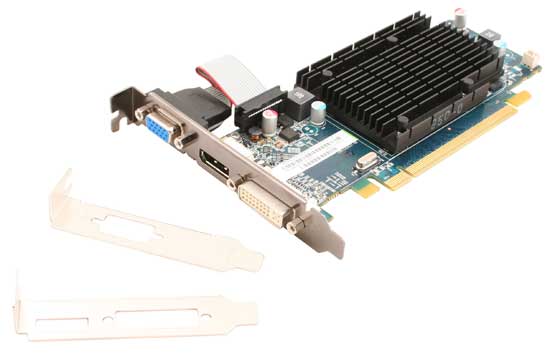AMD’s Radeon HD 5450: The Next Step In HTPC Video Cards
by Ryan Smith on February 4, 2010 12:00 AM EST- Posted in
- GPUs
Meet the Sapphire 5450
Along with our reference card from AMD, Sapphire also sent in their near-reference 5450. As it was clocked correctly at 650MHz/800MHz, we were able to use this card to benchmark the 5450 at its proper clocks, so we’d like to thank Sapphire for sending this in.

The Sapphire 5450 is nearly identical to AMD’s reference card. It uses the same PCB and the same port configuration, and the RAM chips are the appropriate 800MHz Samsung DDR3 chips. The key difference between the two cards is that while AMD is using a double-wide heatsink, the Sapphire 5450 is using a smaller single-wide heatsink. This means that the Sapphire 5450 will fit in to cases where only a single slot’s worth of space is available below the card.

However on the flip side (in all senses of the word) Sapphire’s heatsink wraps around the card slightly, which results in it sticking up from the back side of the card. Technically speaking the heatsink is encroaching on the space that belongs to the card above it, so the Sapphire card won’t fit if there’s a card more than 2 inches long in the slot above it, or if there are tall motherboard components there. In our case it encroached on the audio riser card for our Rampage II Extreme Motherboard. This shouldn’t be a problem for the vast majority of users and is more compatible than a card with a double-wide heatsink, but nevertheless check your case to make sure there’s room for the heatsink on the back side of the card.

As is usually the case with bottom-tier cards, Sapphire packs the 5450 with very little. It comes with a driver CD, the low-profile brackets for the card (it ships with the full-profile bracket installed), an instruction manual, and ArcSoft’s SimHD plugin for upconverting video conferencing feeds. Surprisingly, all of this comes in a full-sized box – this is the first sub-$100 card we’ve seen in some time to not come in a mini-box.
Sapphire also sent along their entire 5450 product chart. Of note, they will be releasing DDR2 and DDR3 cards with HDMI ports that are otherwise identical to today's DisplayPort card, so HTPC users will not be left out in the cold.










77 Comments
View All Comments
uibo - Thursday, February 4, 2010 - link
Why don't the Radeon "Cheese Slices" video screenshots have horizontal lines? The Nvidia ones have them...Ryan Smith - Thursday, February 4, 2010 - link
It's an artifact of stepping through the video one frame at a time with MPC-HC with the MS MPEG-2 decoder. Doing so captures the angled lines correctly, but it doesn't quite capture some of the other artifacts exactly the same because it ends up a field (basically half a frame) ahead.In motion the Radeon cards are getting it right.
blaubart - Tuesday, February 9, 2010 - link
Congrats Ryan, your Cheese Slices testing outside of a HTPC forum was really a big surprise for me! Keep on pushing AMD/Nvidia to realize that there's more than gamers in this world!> Horizontal 1p lines missing:
I'm also wondering normally the 1p lines are no problem in screenshots (MPC-HC and more). Maybe you shot them during the "odd movement" (1h+3v see description in Cheese Slices thread). I have now edited Post #1: screenshots only during "even movement".
This link shows it (sorry German):
http://www.dvbviewer.info/forum/index.php?s=&s...">http://www.dvbviewer.info/forum/index.p...c=34863&...
1080i-1 ---> odd movement
1080i-2 ---> even movement
What's more, GT220.png and G210.png show MA in 1p and "respone - noise" but VA in the ticker, How did you manage this? Ah I see, you left a mailaddress, I will send you a mail.
uibo - Thursday, February 4, 2010 - link
Oh and the Nvidia G210 has some artifacts for the vertical lines with some pixels shifted right.silverblue - Thursday, February 4, 2010 - link
...then this might call for an article to look at it in that very light. However, is there a higher performing part for both series that can be directly compared? I'm guessing not, as they all differ in some way, be it shader numbers, ROPs or texture units. The only way I can think to do it would be comparing two 512MB 4850s to a downclocked 5870, but even if that were possible, you'll still get a performance drop due to Crossfire. Hmm.MrSpadge - Thursday, February 4, 2010 - link
5770 is as close as it gets. THere's the difference in the memory subsystem, though. Could be that the best bench to run would be ShaderMark.GeorgeH - Thursday, February 4, 2010 - link
You mention the Sapphire's heatsink quite a bit, but I didn't see any pictures of it (at least the reverse side) in the article; was that an oversight or am I blind?Ryan Smith - Thursday, February 4, 2010 - link
Oversight. I thought I had a stock photo of the rear. I'll get one in the morning.If you're really curious, it's the same heatsink that's on their 4350, which there are plenty of pictures of.
GeorgeH - Thursday, February 4, 2010 - link
I see it now, thanks - it's actually not nearly as "bad" as I thought it'd be.Ryan Smith - Thursday, February 4, 2010 - link
Oversight. I thought I had a stock photo of the rear. I'll get one in the morning.